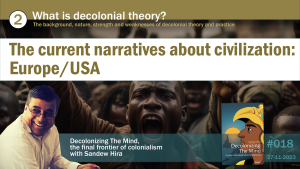Sandew Hira has written an essay about the future of the decolonial movement. He argues that a major problem of the decolonial movement is of a theoretical nature. The problem is that it is not a comprehensive, coherent and integral framework.
What happens to a social movement when it has no comprehensive, coherent and integral theoretical framework?
The first consequence is that the movement has no road map to develop practical policies to change the world.
The second consequence is that the movement becomes fragmented at its core.
The third consequence is that there are no organizational guidelines for how to build a decolonial movement.
The last consequence is that the decolonial movement will lose its relevance for social struggle and will become obsolete.
Hira proposes that we move towards a comprehensive, coherent and integral decolonial theoretical framework. This enables us to overcome the current defects of the decolonial movement. He made a first attempt to develop such a framework under the label Decolonizing The Mind (DTM).
Based on the theoretical framework he goes into the question of organization: how to organize the decolonial movement.
The essay can be downloaded here. It is the basis for the work of the DIN secretariat.






